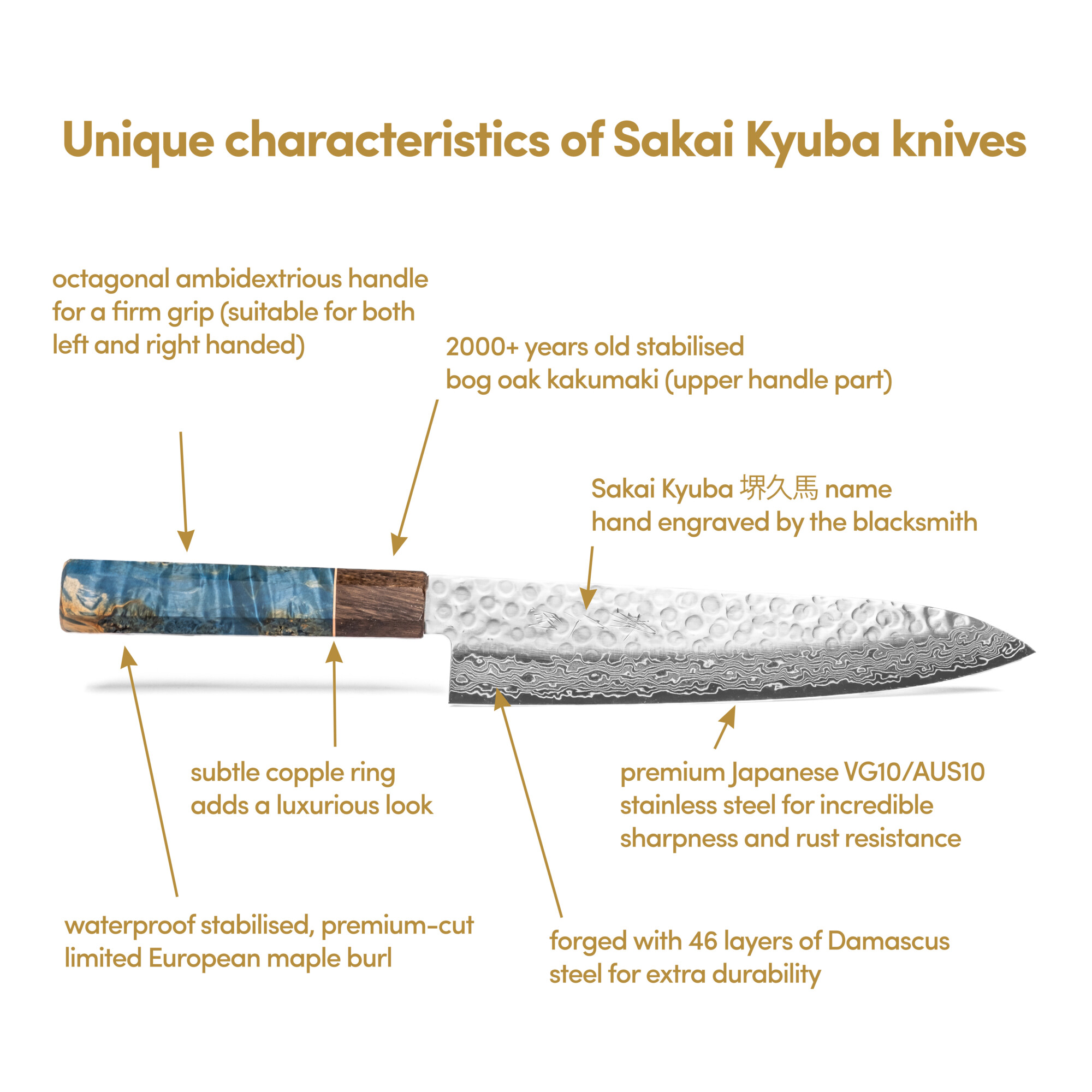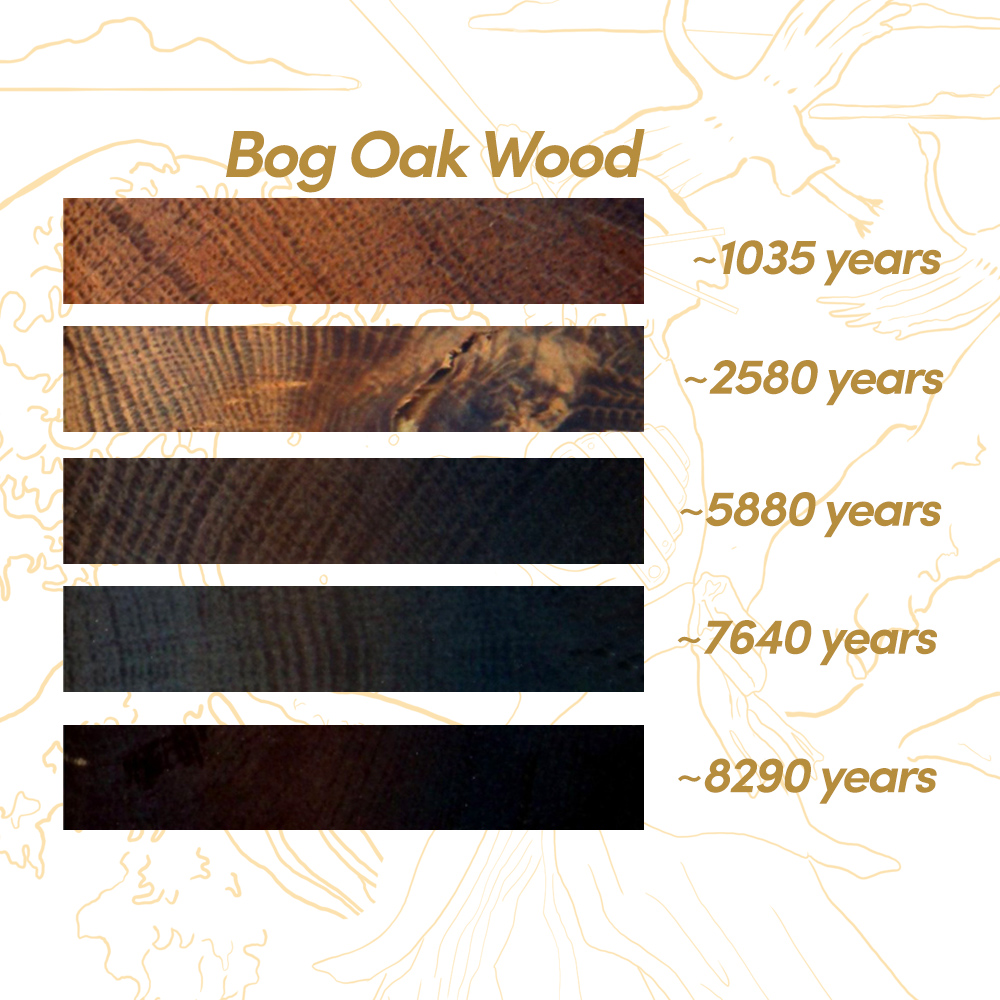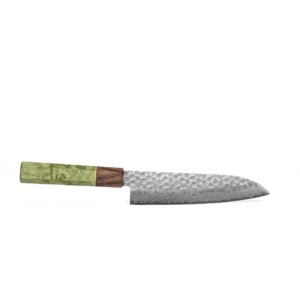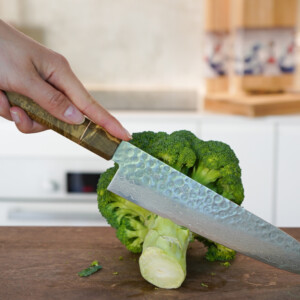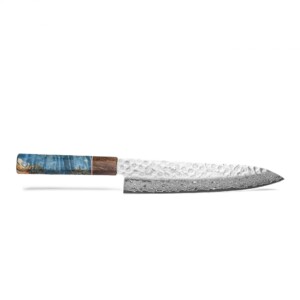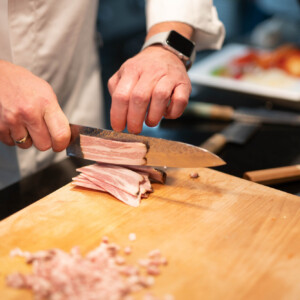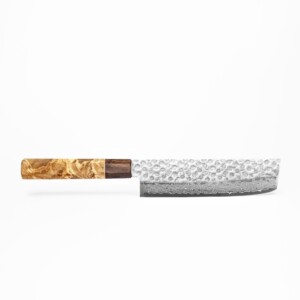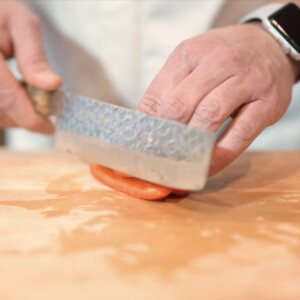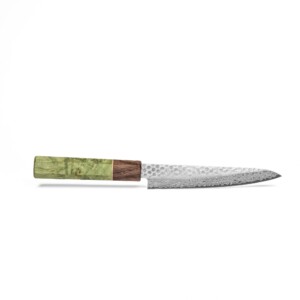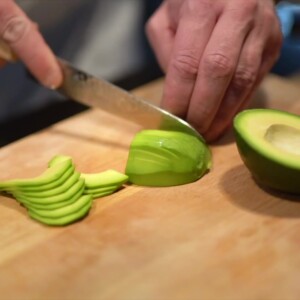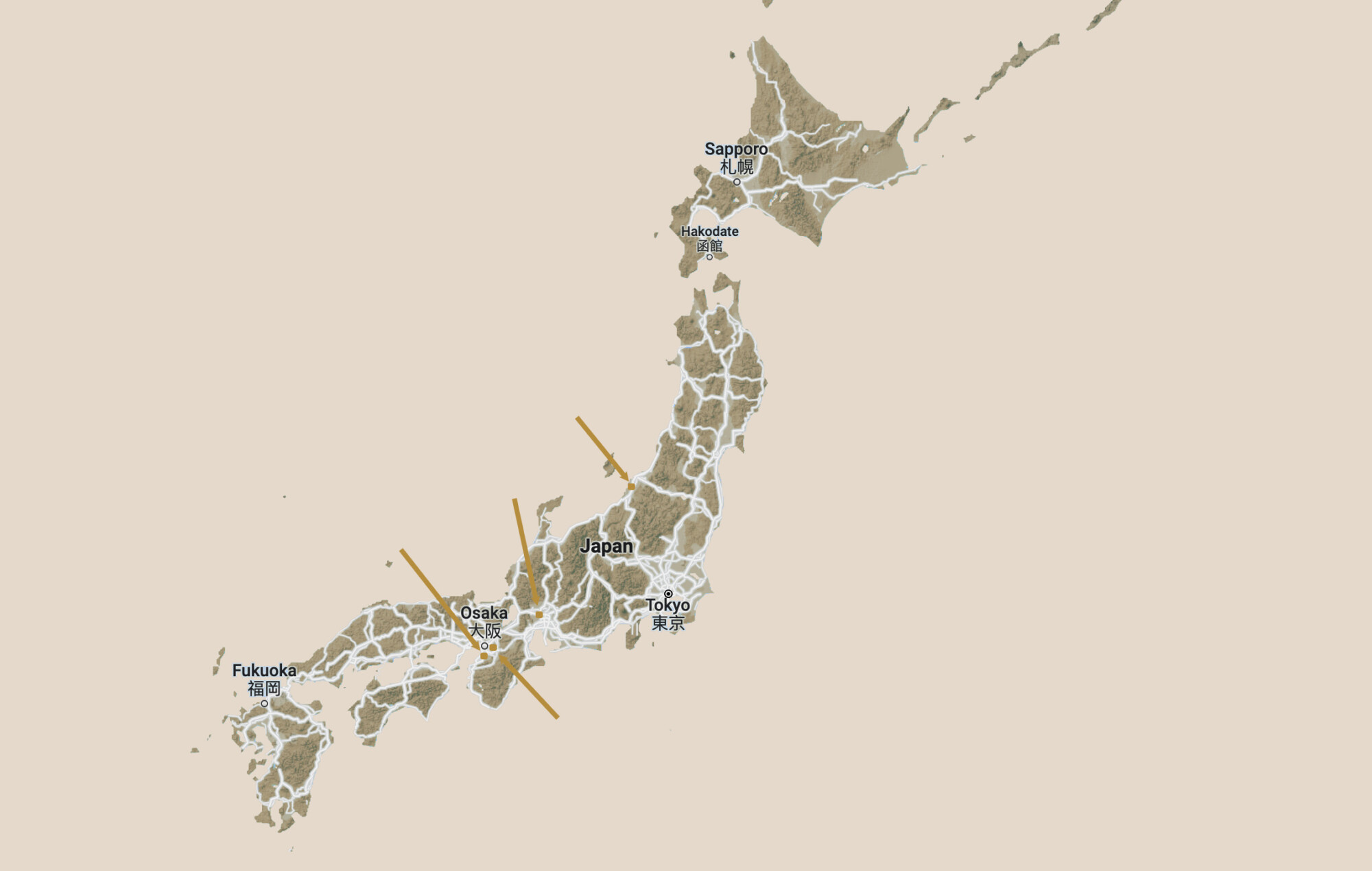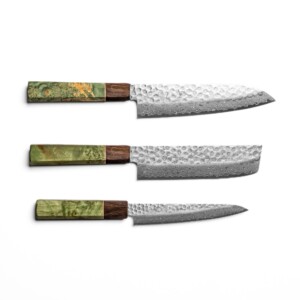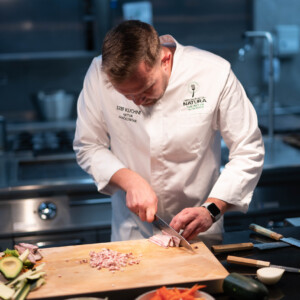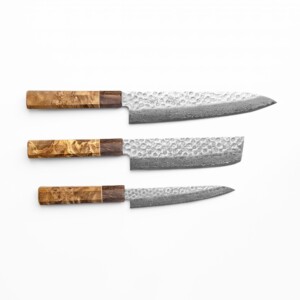Introducing: Sakai Kyuba
Under the Sakai Kyuba 堺久馬 brand lies the artistry of one of the most famous blade masters in Sakai (Osaka Prefecture), Japan, drawing from over 600 years old blacksmithing tradition.
Our blacksmith established himself in 1927 and combines Sakai’s centuries-long history of knife making knowhow with newer technologies to create superior knives. In other words, he is devoted to honouring Sakai’s rich knife making history techniques whilst making improvements to create truly unique, innovative, and one of a kind knives. He is known for making knives for multiple users such as household users, cooking schools and chefs.
At Oishya we spent years searching for the ideal Japanese blacksmith to make our blades. Once we finally found him we encountered a problem. Due to geolocation exclusivity reasons, the blacksmith’s name couldn’t be included in our knives. We weren’t willing to let go of his outstanding artistry that easily, so together we created these knives under our dedicated brand name “Sakai Kyuba 堺久馬” .To make the knives even more unique, a team of talented European artisans is chosen to make the colourful maple burl handles.
Shop Sakai Kyuba Chef's: Gyuto or Santoku
Gyuto: Japanese Sakai Kyuba Chef’s knife for general use such as chopping and slicing. Gyutos are usually double-bevel (can be used by left/right-handed users – especially when the handle is octagonal or oval like our Sakai Kyuba Gyuto chef’s knife
Santoku: As adaptable as the Gyuto but with a shorter length, the Sakai Kyuba Santoku is also double-beveled, making it excellent for slicing, chopping, and dicing meat, fish, and vegetables—often referred to as the “three virtues.”
Both Sakai Kyuba Gyuto and Sakai Kyuba Santoku are available in Mediterranean Blue, Olive Green and Natural Brown
Shop Sakai Kyuba Veggie: Nakiri
Nakiri: Japanese Sakai Kyuba Nakiri knives are the Japanese style knives used mostly for cutting vegetables. They feature a thin and wide blade and squared off tips. As it is designed for chopping veggies, the knife has a straight blade that can cut through long items (think aubergines, carrots) as well as make super thin slices out of cucumber, bitter gourd, tomatoes and the likes. Nakiri knives are the double-edged Western style equivalent of a single edged Japanese usuba knife. Thanks to their straight blade, nakiri are ideal for julienne, brunoise allumette and other precision knife cuts for vegetables. Also, a great tool for cutting into very hard-skinned produce like pumpkins and squash.
Sakai Kyuba Nakiri is available in Mediterranean Blue, Olive Green and Natural Brown
Shop Sakai Kyuba Pairing: Petty
Petty: Sakai Kyuba petty knives are small utility or paring knives that are ideal for small, delicate work that a chef’s knife can’t handle, such as delicate produce and herbs, small fruits and vegetables, most of the time treated as a mini chef’s knife. It works perfectly for cutting soft as well as hard veggies, from tomatoes to squash. It is also very useful when you want to prepare lettuces, cabbage, and sandwich meat.
Sakai Kyuba Petty are available in Mediterranean Blue, Olive Green and Natural Brown
Where is Sakai Kyuba from
What is so special about Sakai Kyuba?
Japanese knives are handcrafted using the same methods that were used to make samurai swords over 1,000 years ago. Over the years, the Japanese have perfected their blade making techniques, which have resulted in knives with a strong reputation and unmatchable quality.
At Oishya, we collaborated with one of the most respected and talented blacksmiths from Osaka under the name Sakai Kyuba. Our blades are handcrafted in Sakai, the birthplace of traditional Japanese knives with a 600 year old blacksmithing tradition. Each blade is meticulously forged using techniques perfected by our blacksmith’s family over centuries.
As true high quality Japanese knives, our Sakai Kyuba blades are forged on a small scale and are made by hand. It takes more than 3 months and around 220 steps to craft one Sakai Kyuba knife. They are not just knives, they are unique pieces of artwork.
Who is Sakai Kyuba?
Good to know
Who is Sakai Kyuba 堺久馬?
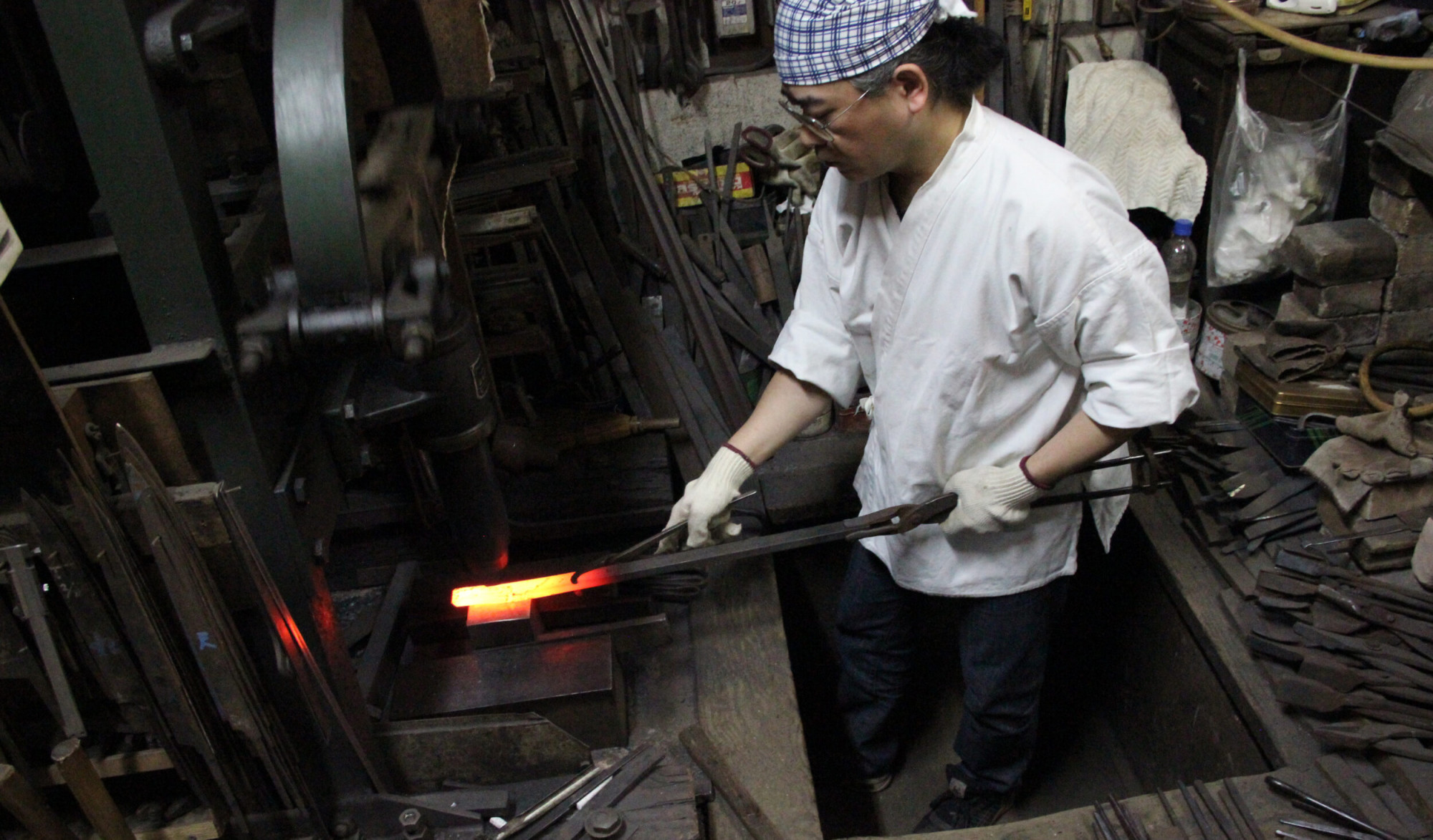
Sakai Kyuba 堺久馬 is the name of our line of Japanese kitchen knives. Under the Sakai Kyuba 堺久馬 brand lies the artistry of one of the most famous blade masters in Sakai (Osaka Prefecture), Japan, drawing from over 600 years old blacksmithing tradition.
What are Sakai Kyuba 堺久馬 blades made from?
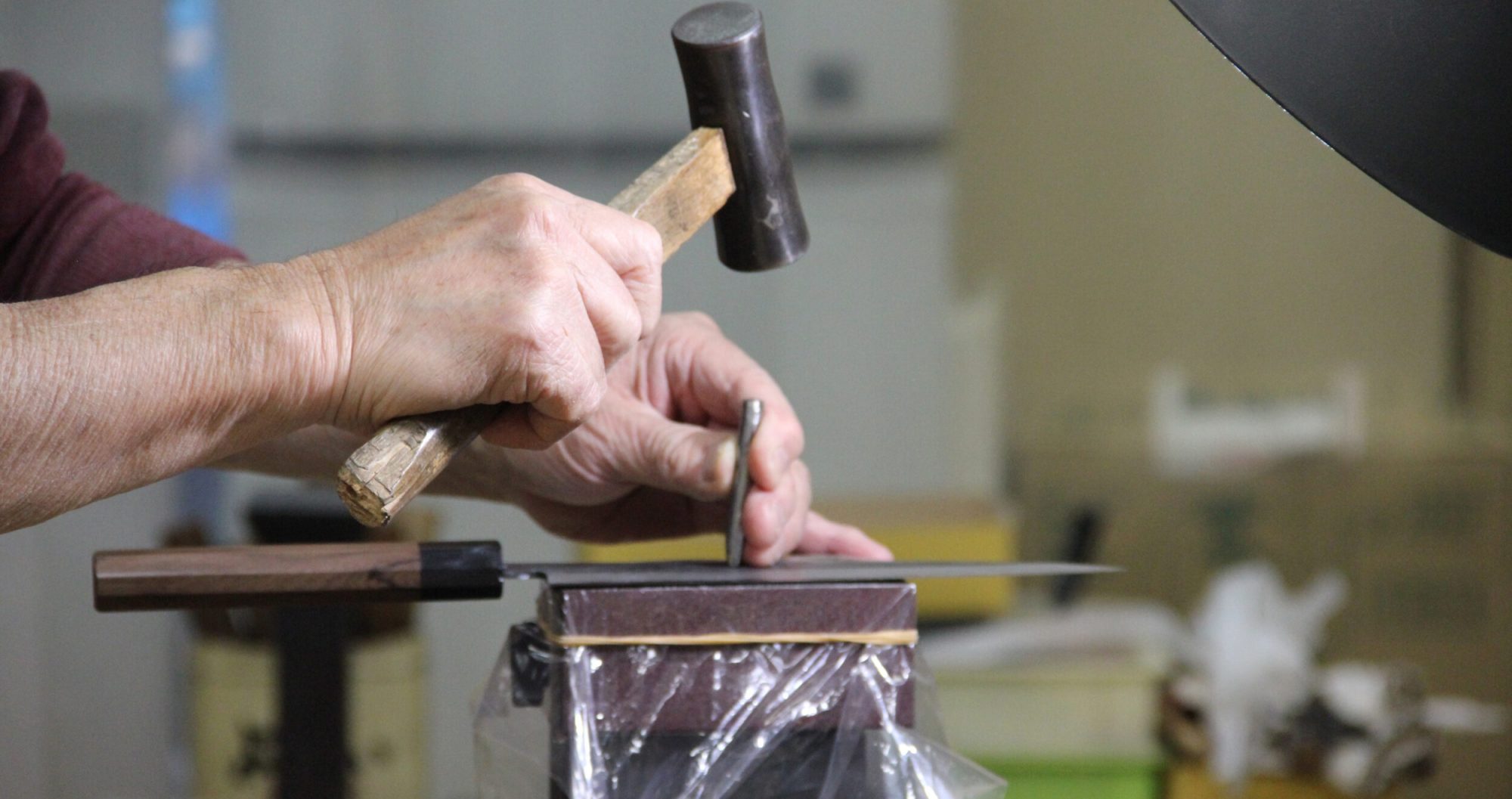
Lifetime guarantee
Here at Oishya we make sure that the products we send to you are checked for exceptional quality and that the packaging is always secure and sturdy, so that you receive undamaged, high quality goods which will last a lifetime. We believe our customers should not worry about buying premium products online, this is why our Sakai Kyuba range comes with a lifetime guarantee. The lifetime guarantee covers any defects in manufacturing and materials that functionally impair the knife. Oishya will repair or replace any of the Sakai Kyuba products free of charge. Please note that in the case of a set, only the faulty item will be replaced. Our lifetime guarantee does not cover:
- Damage caused by normal wear and tear, accident or negligence.
- Damage caused by improper use (knocks, dents, crushing, drops, etc.).
- Damage due to loss, theft, fire or other causes beyond our control.
- Damage caused by commercial, professional, or workplace use.
- Damage due to improper storage.
All returned items will be posted at the buyers expenseif sent after 50 days of purchase other than where it’s a manufacturers fault. In this instance we will be happy to refund any postage costs along with arranging a replacement. You will need to send us a copy of your postage receipt in order to receive a refund. If you have any quality concerns, please contact us at info@oishya.com.
Where are Sakai Kyuba knives made?
Every single Saki Kyuba 堺久馬 blade has been meticulously handmade, forged and hand-polished in Japan by master craftsmen in Sakai. Whilst the beautiful handles are crafted by artisans in Europe using limited European maple burl.
How long will my knife stay sharp?
This really depends on how often you use the knife, how you care for it and what items you’re cutting. In general, Japanese knives tend to hold their edge longer than Western knives. In other words, Japanese knives stay sharper longer than their Western counterparts. When tested, Sakai Kyuba knives outperformed brands that cost much more. We estimate that for a person cooking 5 times a week, Sakai Kyuba knives will stay sharp for around 4-8 months. However, no knife — including ours — will stay sharp forever. Which is why we provide a variety of sharpening stones, so when the blade starts to dull, you can sharpen it easily at your home in 5-10 minutes. Otherwise, check out our recommended trusted knife sharpening services.
Does it make sense to buy one knife first, and not a set?
If you can’t afford or do not want to commit to buying a set immediately, the single most important tool in your kitchen is The Gyuto – The Chef’s Knife. It’s the workhorse you reach for most often. Investing in one great knife now will change your cooking for life and make it a pleasure rather than a chore. Our Sakai Kyuba Gyuto can do 99% of your kitchen cutting. Another option for a daily knife is Santoku knife. However, if you’re looking for an ultimate experience, you should consider investing in a 3-pieces set; including The Petty (Paring/Utility Knife), Nakiri (Veggie/Fruit Knife) in addition to The Gyuto (The Chef’s Knife).
Do these knives require special care?
Sakai Kyuba knives are extremely durable and easy to care for. However, any knife, even a premium one needs sharpening at some point. As a good habit, you should sharpen them regularly and dry them immediately after use. These are 3 general rules you should follow:
- Don’t put your knife in a dishwasher.
- Store your knives either on the magnetic knife strip, knife stand, or sheathed in the utensil drawer.
- Don’t slide your knife, blade down, across the cutting board to clear away what you just chopped.
Also, check our full guide on how to properly maintain the knife and sharpen it
What is bog oak?
Bog wood comes from trees that have been buried in peat bogs and preserved from decay by the acidic and anaerobic bog conditions. This wood ranges in age from 2,500 to 5,000 years. Bog oak is known for its exceptional strength and often used to make luxury furniture and interiors. Its age and living conditions give it a unique character and rich natural colour variation determined by its age. Its colour gradually darkens with age going from a light, golden brown to an almost ebony-black colour.
The handles of Sakai Kyuba and Seki Kyuba knives are made of a waterproofed bog oak wood that are minimum 2000 years old! Now, that’s special 🙂
